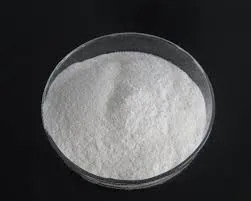
تشرینی دووەم . 16, 2024 13:56 Back to list
hydroxyethyl cellulose viscosity concentration
Understanding Hydroxyethyl Cellulose Viscosity and Concentration Relationship
Hydroxyethyl cellulose (HEC) is a widely used cellulose ether, renowned for its unique properties that make it suitable for various applications across industries such as pharmaceuticals, cosmetics, food, and construction. One of the critical attributes of HEC is its ability to modify viscosity, which is significantly influenced by its concentration in solution. This article explores the relationship between hydroxyethyl cellulose viscosity and concentration, shedding light on its implications and applications.
What is Hydroxyethyl Cellulose?
Hydroxyethyl cellulose is a non-ionic, water-soluble polysaccharide derived from cellulose, a natural polymer obtained from plant cell walls. To produce HEC, cellulose is etherified using ethylene oxide, which introduces hydroxyethyl groups into the cellulose chain. This modification enhances solubility in water compared to unmodified cellulose, enabling HEC to function effectively as a thickener, binder, and stabilizer in various formulations.
Viscosity A Key Property of Hydroxyethyl Cellulose
Viscosity is a measure of a fluid's resistance to flow and deformation. In the case of hydroxyethyl cellulose solutions, viscosity is primarily dependent on both the concentration of HEC and the shear rate applied to the solution. Typically, as the concentration of HEC increases, the viscosity of the solution also increases. This relationship is crucial for manufacturers who need to control the consistency and performance of their products.
The Viscosity-Concentration Relationship
The viscosity of HEC solutions can be described by various models, with the most common being the power-law model, which illustrates that viscosity increases exponentially with an increase in concentration. At low concentrations, the solution behaves more like a Newtonian fluid, where viscosity remains relatively constant regardless of the shear rate. However, as the concentration increases, the solution transitions to a non-Newtonian behavior.
hydroxyethyl cellulose viscosity concentration

This non-Newtonian behavior is characterized by shear-thinning properties, where the viscosity decreases with increasing shear rate. This property is particularly advantageous in applications such as paints and coatings, where high viscosity is favorable for application, but lower viscosity is needed for ease of spreadability.
Practical Applications of Viscosity Control
1. Pharmaceuticals In the pharmaceutical industry, hydroxyethyl cellulose is used to prepare gels and suspensions. The viscosity of HEC solutions can significantly impact drug delivery systems. For example, achieving the ideal viscosity ensures that the gel retains the active ingredient while providing the desired release profile.
2. Cosmetics In cosmetic formulations, HEC acts as a thickener and stabilizer. The appropriate viscosity can enhance the texture and application of creams and lotions, making them more appealing to consumers.
3. Food Industry HEC is also utilized in food products as a thickening agent. The viscosity must be finely tuned to achieve the right mouthfeel and stability of food products, such as sauces and dressings, ensuring they remain homogeneous and appealing.
4. Construction In construction, HEC is employed in cement and mortar formulations. Controlling the viscosity is essential for workability and adhesion properties, affecting the application and durability of construction materials.
Conclusion
The relationship between hydroxyethyl cellulose viscosity and concentration is crucial for various industries that rely on this versatile polymer. By understanding and manipulating this relationship, manufacturers can create formulations that meet specific performance criteria. As the demand for more effective and tailored products continues to grow, the role of hydroxyethyl cellulose will undoubtedly remain pivotal across different sectors. This adaptability and functionality make HEC a vital ingredient in formulating products that require precise viscosity control, thereby highlighting its importance in modern applications.
-
Versatile Hpmc Uses in Different Industries
NewsJun.19,2025
-
Redispersible Powder's Role in Enhancing Durability of Construction Products
NewsJun.19,2025
-
Hydroxyethyl Cellulose Applications Driving Green Industrial Processes
NewsJun.19,2025
-
Exploring Different Redispersible Polymer Powder
NewsJun.19,2025
-
Choosing the Right Mortar Bonding Agent
NewsJun.19,2025
-
Applications and Significance of China Hpmc in Modern Industries
NewsJun.19,2025







